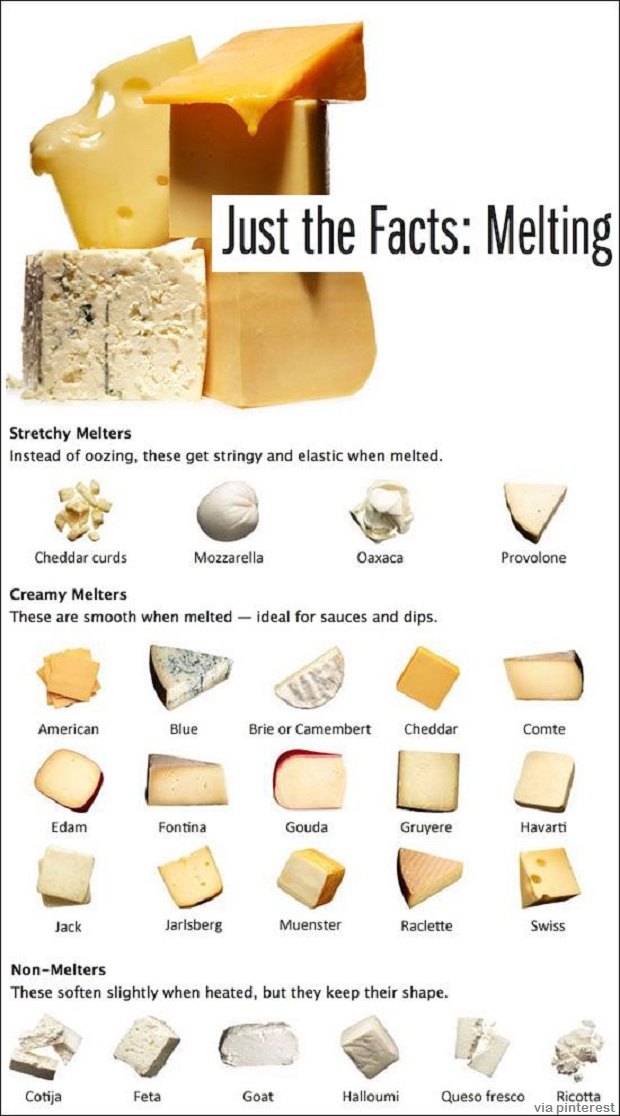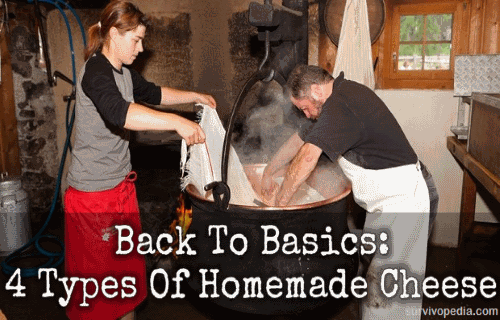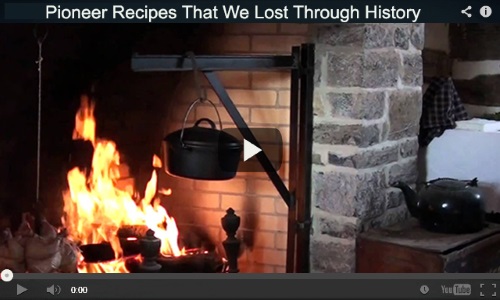Without a doubt, life is made tastier by cheese. We put it on everything from burgers to macaroni and kids love it. We mix it in sauces to add flavor and texture and we eat it plain as a snack. It’s a great source of calcium and protein and most kids will eat cheese even when they won’t eat many other foods.
However, if SHTF, cheese is quickly going to a hot commodity because it’s not something that keeps for long. This is when your skills as a cheese maker will come in handy.
The history of cheese is a long one; some say cheese has been around for as long as 10,000 years! It started when somebody noticed that the milk that they stored in their vessel (a calf stomach) turned into a hard block. Some brave soul decided to taste it and found out that it was delicious. Thus cheese was born. Find out more about preserving milk here.
Cheese recipes have often been passed down from generation to generation, along with the cultures that are necessary to make the cheese. Some are extremely easy to make and don’t require a culture but the tastier and more advanced cheeses do. Before we get started, you need to understand some basic cheese-making ingredients.
Rennet
Rennet is derived from the stomach lining of ruminate animals, namely the fourth stomach of calves. It’s an enzyme that helps the baby animal to digest its mother’s milk. There are also vegetable rennets, microbial rennets that are derived from mold and genetically engineered rennets that are made by injecting cow DNA into plants.
{adinserter survivalmd}Rennet, or more specifically chymosin, the enzyme in rennet, separates the curds from the whey during the cheese-making process. Milk would curd on its own but by the time that happens, the milk is sour. Rennet allows you to make curds quickly from sweet milk. Most European cheeses are made with rennet while most cheeses made in the US are made using different products.
There are several cheeses, including Mozzarella, cottage cheese and cream cheese that don’t require rennet. This is because you can substitute vinegar, lemon juice or citric acid to create the curd. The difference between rennet and another acid is that rennet slowly curdles the cheese and vinegar or citric acid does it quickly. To get the flavor or texture you need for aged cheeses, you need rennet.
Cheese salt
You’ll often see recipes that call for cheese salt. Cheese salt is just flakey, non-iodized salt. Salt is used in cheese for both flavor and preservation but don’t ever used iodized salt because it damages the bacteria that you need to make the cheese.
If you don’t have cheese salt, you can use regular uniodized salt or kosher salt. It’s all a matter of how quickly you want the salt to dissolve. Cheese salt is always best, though because it’s flakey and dissolves quickly.
Calcium Chloride
If you’re using milk that’s been pasteurized and stored cold to make your cheese, you need to use calcium chloride to make your curds firm. This is because calcium in store-bought or pasteurized milk slowly becomes soluble and won’t form a firm curd on its own. Exceptions include cheeses that are stretched, such as mozzarella or provolone because the stretch depends on the calcium leaving the curd.
Cheese Culture
Cheese cultures are good bacteria produced from milk that eat away the bad bacteria by feeding on the lactose in the milk. This is necessary in order to encourage coagulation and help develop the flavor of the cheese. You can buy starters from either local specialty stores or online. There are two basic starters: mesophilic and thermophilic.
Mesophilic culture is used in low-temperature cheeses. This includes the majority of cheeses including chevre, cheddar, cottage cheese, brie, sour cream, Colby blue cheese, feta and many others. Sometimes you can sub vinegar or citric acid, such as when you’re making cottage cheese. For aged, harder cheeses, culture is required.
Thermogenic culture is used in recipes that require higher heat and can be heated to 130 degrees F. It’s used to make yogurt and Italian cheeses such as mozzarella, parmesan and provolone. It’s also used to make other softer cheeses such as Swiss and Monterey Jack.
There are several varieties of both of these cultures that you can purchase and come in freeze-dried packets. You have to keep them frozen until you use them. You can make your own starters by saving part of the original starter but they only last a few days in the fridge before the bacteria are no longer effective so you either have to freeze them or use them.
You can also make them from scratch. I found these recipes on cheeseforum.org:
Meso starter:
Start with:
- 2 cups fresh store bought cultured buttermilk.
Directions:
- Set the buttermilk in its container on kitchen counter with lid cracked to relieve pressure and allow to reach 21 C/70 F room temperature to ripen and increase the bacteria population density. After 6-8 hours the buttermilk should be much thicker like fresh yogurt and sourer than at start. If not thick enough, let sit for a few more hours.
- Use as per cheese making recipes and pour remainder into a full sized very clean ice cube tray and put into your freezer.
- Once frozen, remove the cubes and put into a clean sealed labeled container or plastic freezer bag to reduce contamination and freezer burn.
- The resulting ice cubes are each ~30 ml/1 ounce of mesophilic starter. Add cubes (thawed) to your recipe as required.
Thermo starter:
- 2 cups fresh live/active store bought unflavored yogurt.
Use yogurt as thermophilic starter culture as per recipe.
- Pour excess into a full sized very clean ice cube tray and put into freezer.
- Once frozen, remove the cubes and put into a clean sealed labeled container or plastic freezer bag to reduce contamination and freezer burn.
- The resulting ice cubes are each ~30 ml/1 ounce of thermophilic starter. Add cubes (thawed) to your recipe as required.
Water
It’s best to use filtered water in your cheese because some local waters contain ingredients that will prohibit the milk from turning to cheese.
The Chemistry of Cheese Making
Though it sounds like a daunting task, cheese making is a matter of simple chemistry. Milk is about 85% water; the rest is mostly proteins, minerals, fat, vitamins and lactose (milk sugar). When you add an acid, the milk turns into curd, a jelly-type substance. When you heat the acidified milk, the curd separates from the whey (the liquid). The curdling agent is actually a bacteria that eats lactose, which turns it to lactic acid and makes it curdle.
Heating, pressing and aging the curd separates out more of the whey, which makes the cheese sharper-tasting and harder. That’s why people with lactose intolerance often do OK with harder cheeses; there isn’t as much lactose in it.
What Milk to Use
They type of milk you use depends on the cheese but if you’re making starter, you need to use organic milk because if the cow was given antibiotics, those could have passed through into the milk and will prevent the good bacteria from forming that is the basis of the starter. Since that’s what the starter is all about, your starter won’t form. Learn more about raising animals for milk here and how to milk your cow or goat here.
I’ve also found a recipe to make cheese from powdered milk, which I’ll share in a bit. When choosing milk, go for non-homogenized, also called cream-top, if you can. It’s not critical but produces better results, especially if you’re new to the process. Usually, you’ll be better off using full fat milk unless the recipe calls for something different.
Regardless of what type of milk your recipe calls for, it can’t be ultra-pasteurized because the high heat denatures the proteins and will thus prevent curd from forming.

Cream Cheese
- 1 quart of cream (you can also use half and half)
- 1 package (1/8 teaspoon) mesophilic starter
- Salt to taste
Instructions:
- Place cream in glass bowl.
- Cover it loosely and let it set at room temperature for 8-12 hours or until it’s about the same consistency as yogurt. It may not be completely smooth but that’s alright.
- Pour into cheesecloth and allow the whey (liquid) to drain for at least 12 hours. The more liquid you lose, the firmer the cream cheese will be.
- Scrape out of the cheesecloth and add salt. This is when you’d also want to add herbs if you’d like to get fancy!
- Refrigerate. It will get firmer as it chills.
Yield: you should get 1 ½ to 2 cups of cream cheese for each quart of cream that you use. You can double this recipe if you want. It makes a great gift!
Cottage Cheese
This recipe is super-simple and delicious!
Ingredients:
- 1 gallon skim milk
- 3/4 cup white vinegar
- 1 teaspoon salt or to taste
- 1/2 cup heavy cream or half and half
Directions:
- Place skim milk in large saucepan and heat slowly over medium heat to 120 degrees F.
- Remove from heat and slowly stir in the vinegar.
- Continue to stir for a minute or two as the curds separate from the whey.
- Cover with a towel and let the mixture sit for about 20 minutes.
- Pour into a colander lined with cheese cloth or a lint-free towel to drain off the whey. It takes about 5 minutes.
- Gather the edges of the towel and rinse the curds under cold water for a couple of minutes until they are completely cool. Squeeze and squish the mixture as you do so.
- Squeeze as much moisture from the curds as possible.
- Put the curds in a bowl and mix in the salt, breaking up the curds into smaller cottage cheese-sized chunks.
- If you want to eat it immediately, add the cream or half and half. If not, refrigerate the curds without the cream and add the cream immediately before serving.
Mozzarella Cheese
This recipe calls for rennet but there are some recipes out there for making it without. This one is delicious, though.
Ingredients:
- 1 gallon whole cow or goat milk
- 1 1/2 tsp powdered citric acid dissolved in 1/4 cup cool water
- 1/4 tsp liquid rennet diluted in 1/4 cup cool water
- 1 to 2 tsp cheese salt
Directions:
- Pour the milk into a stainless steel pot and slowly heat on medium to 55 degrees F.
- Slowly and thoroughly stir in the citric acid solution.
- Heat the milk to 88 degrees F on low-medium heat until it’s the consistency of yogurt.
- Gently stir in the rennet for about 30 seconds when it reaches 88 degrees F.
- Without stirring, let it heat to 100-105 degrees F slowly. This should take 5-8 minutes. The curds will begin to form and pull away from the sides of the pot. The curds will look like shiny chunks of thick yogurt and the whey will be almost clear. If it’s not, cook it for a few more minutes.
- Remove from heat and scoop the curds out into a bowl with a slotted spoon. Don’t discard the whey.
- With your hands or a wooden spoon, gently press the cheese against the sides of the bowl to press out as much whey as possible.
- Turn the heat back on under the whey and bring it to 175 degrees F.
- Shape the curds into small balls, between the size of a large egg and a tennis ball. Dip each one into the whey using a large spoon or ladle for several seconds. Place the balls together back into a dry bowl.
- Knead the cheese balls together like you do bread dough. It’s going to be really hot so you want to use heavy gloves or a spoon to do this. This distributes the heat throughout the cheese and is necessary because the cheese won’t stretch until it’s too hot to touch.
- Repeat several times, adding the salt in after the second time until it’s smooth and pliable, sort of like dough. When it’s stretchy like taffy, it’s done. If the curds break up instead of getting stretchy, don’t panic. It’s just cooled too much and needs to be re-heated. Do this by either microwaving for 30 seconds or pouring hot water over them until they’re 135-145 degrees F again.
- Roll the cheese into balls the size of tennis balls and it’s done! You can eat it immediately or store in the fridge for up to a week.
Cheddar Cheese
We all love cheddar! This recipe is simple and delectable.
Ingredients:
- 2 gallons whole cow or goat milk
- ⅛ tsp calcium chloride diluted in ¼ cup water (optional)
- 1 packet direct-set mesophilic culture or ⅛ tsp bulk mesophilic culture
- Rennet, dissolved in ½ cup cool water (choose one):
- ½ tsp liquid animal rennet or
- ¼ tsp double-strength liquid rennet or ¼ tablet vegetable rennet
- 2 tbsp salt
Instructions:
- Pour the milk into a large stainless steel pot and heat to 85 degrees F, stirring often. If you’re using the calcium chloride, stir it in as the milk is heating.
- When the milk reaches 85 degrees F, remove from heat and add the culture and stir from the bottom to the top to ensure that it’s infused throughout the milk.
- Cover and allow to ferment for an hour.
- Add the diluted rennet, stirring in an up and down motion. This helps the rennet work its way through the milk so that you get the highest yield of cheese.
- Let the cheese set for about an hour or until the curds start to separate from the whey. The curd will be pulling away from the top of the pot and the whey will be mostly clear and floating on top of the curd.
- Use a knife to cut the curd into small (1/4 inch) cubes and let it set for 5 more minutes without stirring.
- Over low heat, bring the curds to 100 degrees F, stirring frequently. The curds will shrink as it heats.
- Once it’s reached 100 degrees F, continue stirring over low heat for the next 30 minutes. It’s important that the temperature stays at 100 degrees; if it gets hotter, remove from heat for a few minutes.
- After warming and stirring for 30 minutes, remove from heat and allow the curds to settle to the bottom. This will take 20 minutes or so.
- Pour the curds into a colander and allow to drain for 15 minutes.
- Pour the curds back into the cheese pot and cut into 5 or 6 wedges and cover.
- Fill your sink with water that’s 102 degrees F. Place the pot of curds into the water.
- Keep the water at 102 degrees F and turn the chunks every 15 minutes or so for 2 hours. This step is important because it’s what makes your cheese cheddar and gives it that unique flavor.
- After 2 hours, the chunks will be very firm and shiny. Remove them from the pot and cut into ½ inch cubes.
- Place the curds back into the pot that is still sitting in the 102-degree F water and leave them there for another 10 minutes.
- Stir gently with your fingers. Repeat this process twice more.
- Remove the pot from the water and stir the cheese gently, adding the salt.
- Line your cheese press with cheese cloth.
- Wrap the cheese cloth around the cheese and press with 10 pounds of pressure for 15 minutes.
- Remove the cheese from the press, unwrap it and flip it onto a fresh piece of cheesecloth.
- Press at 40 pounds of pressure for 12 hours.
- Remove cheese from press, unwrap and flip the cheese.
- Rewrap in fresh cheese cloth and press at 50 pounds of pressure for another 24 hours.
- Remove from press and allow cheese to air-dry for 2-3 days until it’s smooth and dry.
- If it’s too big of a chunk for you to eat before it goes bad once it’s finished, cut into smaller chunks.
- Paint with wax and store it in a cool area between 55 and 60 degrees F.
- Allow it to age for at least 60 days. The longer it ages, the sharper it will be.
Now you know how to make some of your favorite cheeses. I started with easy ones to give you confidence. Once you’re comfortable with these, move on to some fancier ones.
This article has been written by Theresa Crouse for Survivopedia.
Our grandfathers had more knowledge than any of us today and thrived even when modern conveniences were not available. They were able to produce and store their food for long periods of time. The Lost Ways is the most comprehensive book available. All the knowledge our grandfathers had, in one place.Here’s just a glimpse of what you’ll find in the book:
The Lost Ways is a far–reaching book with chapters ranging from simple things like making tasty bark-bread-like people did when there was no food-to building a traditional backyard smokehouse… and many, many, many more!
Books can be your best pre-collapse investment.
The Lost Ways (Learn the long forgotten secrets that helped our forefathers survive famines,wars,economic crisis and anything else life threw at them)
Survival MD (Best Post Collapse First Aid Survival Guide Ever)
Conquering the coming collapse (Financial advice and preparedness )
Liberty Generator (Build and make your own energy source)
Backyard Liberty (Easy and cheap DIY Aquaponic system to grow your organic and living food bank)
Bullet Proof Home (A Prepper’s Guide in Safeguarding a Home )
Family Self Defense (Best Self Defense Strategies For You And Your Family)
Survive Any Crisis (Best Items To Hoard For A Long Term Crisis)
Survive The End Days (Biggest Cover Up Of Our President)





